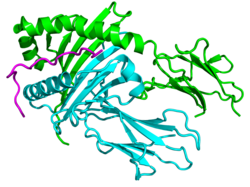Alleles
DQ1
There are four commonly encountered DQA1 alleles: DQA1*0101, *0102, *0103, *0104. These alleles are always found in haplotypes with HLA-DQB1*05 (DQ5) and HLA-DQB1*06 (DQ6). DQ1 is a serotype, rare among serotypes for human class II antigens, in that the antibodies to DQ1 react to the alpha chain of HLA DQ, these DQA1 allele gene products.
Other
The other DQA1 alleles have no defined serotype. There are 5 groups, DQA1*02, *03, *04, *05, *06. DQA1 within these groups are either invariant or produce the same α-chain subunit. DQA1*02 and DQA1*06 contain only one allele. DQA1*03 has three alleles which each produce nearly identical α3. For DQA1*05, the DQA1*0501 and DQA1*0505 produce identical α5. Other DQA1*05 exist that produce variant α5var, but these are rare.
This page is based on this
Wikipedia article Text is available under the
CC BY-SA 4.0 license; additional terms may apply.
Images, videos and audio are available under their respective licenses.







